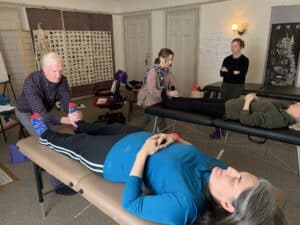Paleo Trekker’s Favorite Dehydrated Lamb Stew
Ever wish for home cooked nutrient-dense meals in the outdoors? Want to avoid those expensive freeze-dried backpacking meals? Prefer to eat Paleo on the trail, or facing food sensitivities? All you need is a little patience, a dehydrator and your favorite stew recipe. We use one of our own favorite recipes to make dehydrated lamb stew. We’ll show you how to tweak the recipe for easy dehydration. And, we give you key tips to make rehydration a snap. The basic techniques can be adjusted to other recipes – check out our dehydrated beef stew recipe.
Paleo Lamb Stew Recipe
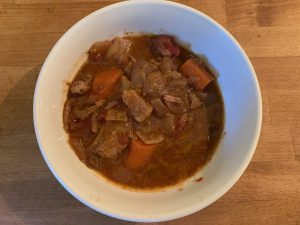
Ingredients:
3 T. olive oil
2.5 lbs. of lamb shoulder, boneless, cut into 1.5 inch chunks
salt & pepper to taste
2 medium onions, chopped
1 lg. red bell pepper, seeded and chopped
4 garlic cloves, minced
1 T. smoked Spanish paprika
1 T. dijon mustard
1 t. coriander
1 t. ground cumin seeds
1 14-oz. can whole peeled tomatoes, with juice
1/2 c. dry red wine
1/2 – 2 c. chicken or lamb bone broth*
2 T. red wine vinegar
3 bay leaves
Warm oil in a large heavy-bottomed pot with a lid over medium-high heat. When oil is hot, sprinkle lamb with salt and pepper and cook until pieces are well-browned on all sides. Transfer to a plate as they brown.
Pour off excess fat, and add garlic, onions and bell pepper. Cook until softened and add paprika, mustard, coriander and cumin. Stir in tomatoes, breaking them into pieces. Add wine, broth, vinegar and bay leaves. Bring to a boil, add lamb chunks and reduce heat. Cover and cook until lamb is tender, stirring occasionally. (On stove top, about two hours.)
*Adjust broth amount as needed. We used an instant pot on the slow cook setting, which required less liquid. We did not braise the meat or saute the onions before hand, as in the original recipe. We further reduced the amount of liquid in anticipation of dehydrating this batch of lamb stew.
TIP: If you use less liquid, it will be easier to dehydrate the stew.
Preparing the Paleo Lamb Stew for Dehydration
After the lamb stew has cooked, you are ready to dehydrate!
You will need:
a high-quality rectangular dehydrator, such as the Excalibur Nine-Tray. These rectangular machines dehydrate the food more evenly than the cheaper round dehydrators.
plastic sheets that fit over the dehydrator trays. The sheets can be purchased on line. These sheets fit over the mesh dehydrator trays, and are designed for dehydrating liquids.
TIP: For faster and more even dehydration and rehydration, shred the meat and any large chunks of vegetable before dehydration. This is very important.
TIP: Weigh the stew before you dehydrate it and after it is done. This will guide you in how much liquid to add for rehydration.
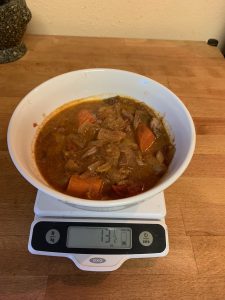
TIP: We like to weigh out one portion at a time, roughly what one person would like to eat on the trail for dinner.
TIP: We spread one portion per dehydrator tray, and later pack the dehydrated lamb stew in single portion bags. (We’ve learned from experience – it is easy to pack too much dehydrated food!) In this case, the single portion size of lamb stew prior to dehydration was 13.5 ounces.
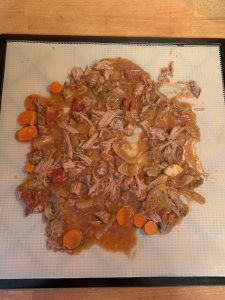
Place the plastic sheets over the dehydrator trays. Spread out the stew evenly onto the plastic sheets. Place the trays in the dehydrator. Dehydrate the stew on the meat or jerky setting (155 degrees). Dehydrate for roughly 10 to 12 hours. When the stew is fully dehydrated, the lamb pieces will feel dry like jerky. The broth will have solidified to a thin, brittle sheet.
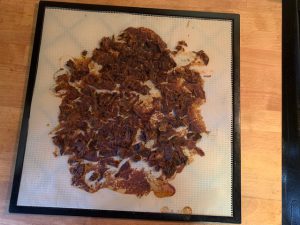
TIP: Dehydration time needed will vary. Many factors affect the time needed for dehydration, including the amount of liquid in the stew, humidity in the air, and the size of any chunks left in the stew.
TIP: If this is your first time making dehydrated lamb stew, I encourage you to check the dehydrator occasionally to watch the progress and get acquainted with the process. Some people move the trays around to different levels, which encourages even distribution of heat.
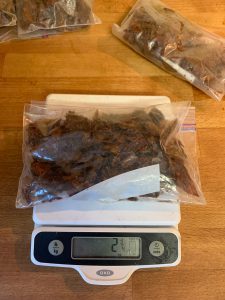
Remember to weigh the stew after it is fully dehydrated. This gives you a guide for how much water to add back. We weighed out single portions, which turned out to be 2.5 ounces after dehydration. (The original weight was 13.5 ounces per portion.)
Storage of Dehydrated Stew
Store your dehydrated lamb stew in plastic ziplock freezer bags, labeled with the date and contents. We like to pack single portion bags, and then put them all together in a larger bag. You may wish to note the weight before and after dehydration.
If you are not going to use the dehydrated lamb stew within a few weeks, it is best to store it in the freezer for future use. Remember that meat, even dehydrated, contains fats and oils which can become rancid, so freezer storage is best for long term.
The shelf life of dehydrated meat dishes, such as dehydrated lamb stew, is not as long as the shelf life for commercially-produced freeze-dried meals which are vacuum sealed. We have stored dehydrated meat dishes in the freezer for up to a year (over the winter when we are not backpacking or camping) before using them. They are edible after a year, but have lost some of their flavor. It’s best to plan to use up your dehydrated lamb stew by the end of the backpacking season.
Rehydration Methods
Add back roughly the amount of water that was removed during dehydration. In the case of the dehydrated lamb stew, we added back slightly less water (8 ounces instead of 10 per portion), because we wanted it a bit thicker.
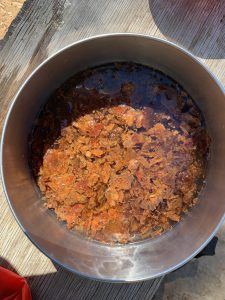
Rehydration time for meat dishes, such as the dehydrated lamb stew, varies. Usually, at least a couple of hours is the minimum. For the dehydrated lamb stew, about 2.5 hours was sufficient, but we left it longer.
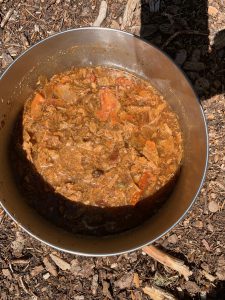
If you have a long day at camp or are staying at the same campsite for two nights, start rehydration earlier in the day, and just let it sit in a pot until dinner time. If you are packing to a new location, you can rehydrate a single portion in a nalgene water bottle or other waterproof container, and let it rehydrate while you walk.
You can shorten the dehydration time by adding boiled water instead of room temperature water. Of course, you should always use potable drinking water for safety and hygiene!
If you wish, you can add dehydrated vegetables to the stew and let them rehydrate, as well. The vegetables need less time and can also be added close to the end.
Paleo Lamb Stew for Dinner on the Trail!
Just heat up the rehydrated stew and enjoy! We added dehydrated mushrooms, carrots and broccoli to our stew shortly before heating it up. (You will have to wait for a future blog post on our methods for dehydrating veggies!)
Elizabeth Zenger, Ph.D., L.Ac., is a licensed acupuncturist in private practice at Inner Works Acupuncture in northwest Portland (and enjoys backpacking!). She is also a certified autoimmune paleo (AIP) coach. For more information or to make an appointment, call 503-227-2127.


